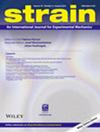一种改进的软胶状和弹性材料的直接剪切表征技术
IF 1.8
3区 材料科学
Q2 MATERIALS SCIENCE, CHARACTERIZATION & TESTING
引用次数: 1
摘要
水凝胶和弹性体等软材料表现出非常低的刚度和强度以及大的变形,这使得通过传统方法对其机械特性进行表征变得极其困难。本文提出了一种新的实验技术来表征这些材料的机械剪切性能。选择琼脂糖水凝胶作为本研究的模型材料。新的平面内剪切试验方法包括用于试样安装的3D打印丙烯腈-丁二烯-苯乙烯(ABS)夹具和用于试样规截面两侧全场应变测量的数字图像相关(DIC)。这些夹具利用倒钩状销钉在施加载荷时固定试样。为了评估该方法,测试了四种浓度的琼脂糖水凝胶(4.0%、2.5%、1.5%和0.5%重量/溶剂体积)。琼脂糖水凝胶的结果显示出优异的重复性。所获得的剪切模量显示出随着凝胶浓度的单调增加。此外,还确定了适用于新型测试方法的剪切模量范围。本文章由计算机程序翻译,如有差异,请以英文原文为准。
An improved direct shear characterisation technique for soft gelatinous and elastomeric materials
Soft materials such as hydrogels and elastomers exhibit very low stiffness and strength as well as large deformations, which makes their mechanical characterisation extremely difficult through conventional methods. This paper presents a novel experimental technique for the mechanical shear property characterisation of these materials. Agarose hydrogels were chosen as a model material for this study. The new in‐plane shear test method incorporates 3‐D‐printed acrylonitrile butadiene styrene (ABS) grips for specimen mounting and digital image correlation (DIC) for full‐field strain measurement on both sides of the specimen gauge section. These grips utilise barb‐like pegs to secure the specimen while load is applied. In order to evaluate the methodology, four concentrations of agarose hydrogel (4.0%, 2.5%, 1.5%, and 0.5% wt./solvent volume) were tested. Results for the agarose hydrogel demonstrated excellent repeatability. The obtained shear moduli show a monotonic increase with gel concentration. Furthermore, the range of shear moduli applicable to the novel testing method was determined.
求助全文
通过发布文献求助,成功后即可免费获取论文全文。
去求助
来源期刊

Strain
工程技术-材料科学:表征与测试
CiteScore
4.10
自引率
4.80%
发文量
27
期刊介绍:
Strain is an international journal that contains contributions from leading-edge research on the measurement of the mechanical behaviour of structures and systems. Strain only accepts contributions with sufficient novelty in the design, implementation, and/or validation of experimental methodologies to characterize materials, structures, and systems; i.e. contributions that are limited to the application of established methodologies are outside of the scope of the journal. The journal includes papers from all engineering disciplines that deal with material behaviour and degradation under load, structural design and measurement techniques. Although the thrust of the journal is experimental, numerical simulations and validation are included in the coverage.
Strain welcomes papers that deal with novel work in the following areas:
experimental techniques
non-destructive evaluation techniques
numerical analysis, simulation and validation
residual stress measurement techniques
design of composite structures and components
impact behaviour of materials and structures
signal and image processing
transducer and sensor design
structural health monitoring
biomechanics
extreme environment
micro- and nano-scale testing method.
 求助内容:
求助内容: 应助结果提醒方式:
应助结果提醒方式:


